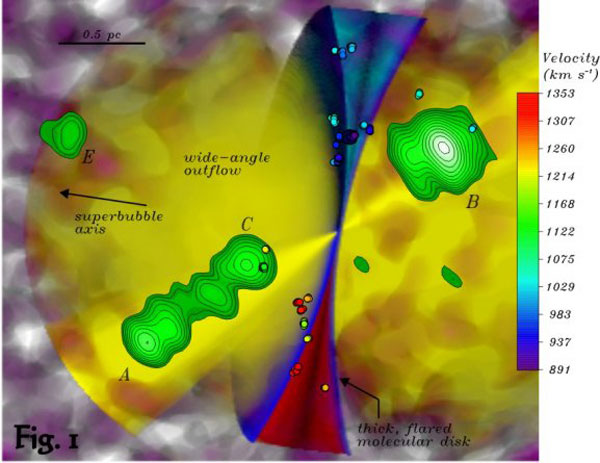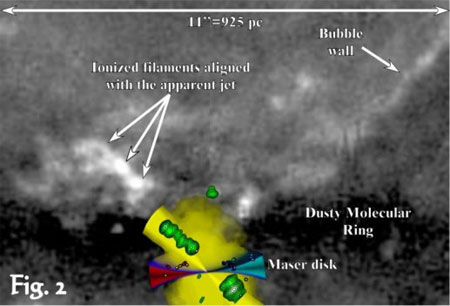Authors:
Paul Kondratko (Harvard University)
Lincoln J. Greenhill (Center for Astrophysics)
James M. Moran (Center for Astrophysics)
VLBA programs: BG7, BG39, BT26, BK83

Supermassive black holes that are millions and billions of times more massive than the Sun are believed to lie in the centers of even ordinary galaxies. In the vicinity of the black holes, infalling gas is compressed and heated forming rotating discs. The importance of these disks lies in what their shape and rotational velocity reveal about the gravity and thus the mass of the invisible black holes. Unfortunately, the disks are difficult to study because they are extremely small in angular size and enshr ouded by stars, gas, and dust.
However, a small fraction of these disks contain water vapor that generates intense laser-like beams of microwave emission (i.e. maser emission) that can be detected when the disks are viewed nearly edge-on. This maser emission can be detected with instru ments such as the VLBA, thereby providing unique images of these important astronomical objects and appreciably improving our understanding of the immediate vicinity of supermassive black holes. In three archetypal maser galaxies, NGC 4258, NGC 1068, and the Circinus galaxy, the black holes are surrounded by thin, well defined, and well behaved accretion disks. Matter slowly spirals towards the center while orbiting in organized fashion the central black hole.
NGC 3079 is a nearly edge-on galaxy that also contains a water maser. The galaxy is known to harbor a supermassive black hole, but the disk encircling the black hole is truly peculiar. The maser emission in this galaxy, imaged with the VLBA and shown as s pots color-coded by Doppler velocity in Fig. 1 (above), is distributed in a disorganized elongated structure not consistent with a thin differentially rotating disk. The presence of a disk is nevertheless strongly suggested because the approaching maser s pots (in blue) are cleanly segregated on the sky from the receding spots (in red) by the axis of the outflow traced by the radio continuum emission (in contours). The maser emission displays large velocity differences in small areas on the sky which impli es that the disk is thick and flared. Consequently, NGC 3079 harbors a thick, flared, disorganized, and possibly clumpy disk, the model of which is shown in a cross-section in Fig. 1 (click the image to see a 360 degree rotation [FLASH]). Maser emission m ost likely occurs in clumps of matter heated by x-rays, which are probably radiated by matter falling onto the central black hole.
Cygnus X-3 is a microquasar at a distance of about 10 kiloparsecs (about 30000 light years), which undergoes periodic radio flares. During these flares the radio brightness increases by a factor of between 10 and 100 from a quiescent level of about 0.1 mJ y to several Jy. This enhanced radio emission originates from relativistic jets moving outwards from the centre of the system. We have used the VLBA to monitor the radio jets at three different frequencies (5, 15 and 43 GHz) over a period of six days foll owing the peak of an outburst in 2001 September.
NGC 3079 came to attention of astronomers because it exhibits a spectacular kiloparsec-scale bubble inflated by a bipolar wide-angle outflow of material ejected from the nucleus. Although the kiloparsec structure of the bubble has been studied in detail, the relationship between the bubble and the central black-hole has remained elusive until now. The radio continuum images obtained with the VLBA (8 GHz image shown as contours in Fig. 1) reveal components that are not all collinear suggesting a presence o f a wide-angle outflow rather than a jet in the immediate vicinity of the supermassive black hole.
 Figure 2 (right) shows in grey-scale an optical image of the base of the bubble obtained with the Hubble Space Telescope by Gerald Cecil and co-workers. The maser features (as spots), radio continuum components (in green), and the model are magnified 250
times and superposed on top of the optical image. As suggested by the figure, the parsec-scale outflow (modeled in yellow) is aligned with the bubble and is characterized by an opening angle similar to that of the bubble. In this manner, a radio continuum
image obtained with the VLBA has for the first time shown what may be a wide angle outflow away from central the black hole thus clarifying the connection between the parsec-scale and kiloparsec-scale outflows in this galaxy.
Figure 2 (right) shows in grey-scale an optical image of the base of the bubble obtained with the Hubble Space Telescope by Gerald Cecil and co-workers. The maser features (as spots), radio continuum components (in green), and the model are magnified 250
times and superposed on top of the optical image. As suggested by the figure, the parsec-scale outflow (modeled in yellow) is aligned with the bubble and is characterized by an opening angle similar to that of the bubble. In this manner, a radio continuum
image obtained with the VLBA has for the first time shown what may be a wide angle outflow away from central the black hole thus clarifying the connection between the parsec-scale and kiloparsec-scale outflows in this galaxy.